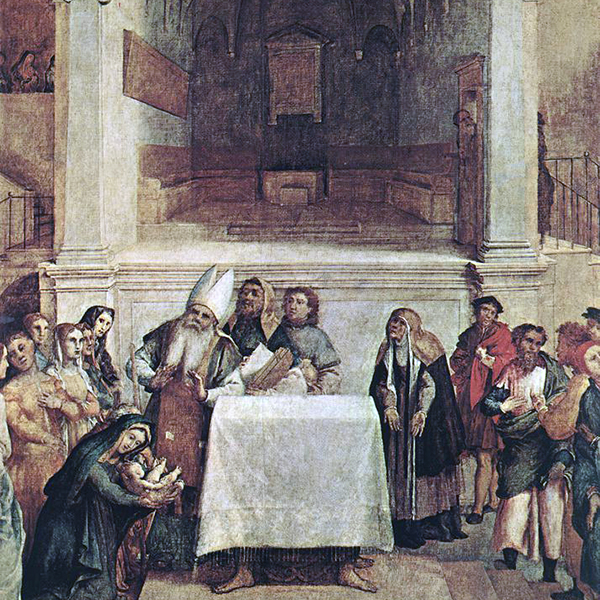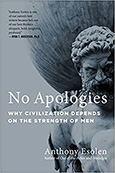Infinite Riches in a Little Room
- ANTHONY ESOLEN
A very old man, wearing the white robe of a Dominican brother, stands at a canvas, his hands trembling.

Join the worldwide Magnificat family by subscribing now: Your prayer life will never be the same!
He is Lorenzo Lotto, one of the finest painters of the Renaissance, but his work has not been appreciated, and for the next three hundred years he will be mostly forgotten.
“Brother Lorenzo,” says his superior, laying a hand on his shoulder, “you should rest. The painting can wait. But why,” he asks, tilting his head a little, “is that dark and empty space above the scene so great, and the figure of our Lord so small?”
In fact almost all the action is to be seen in the bottom half of the painting. There, beside a bare altar covered with a white cloth, stands an old man in the garb of a priest. His long, double-stranded gray beard matches the double peaks of his mitre. He looks on and extends his hands in astonishment, as Mary, gazing into the face of her beloved little child, presents him in the Temple. Others stand about, men and women, talking, or craning their necks to see; and one woman, her shoulders hunched with age, is about to totter forward in excitement. She is Anna, and the old man is Simeon. They have been awaiting the Messiah, the consolation of Israel.
“Father,” says the painter, “you know how much I love the Holy House.” For they are in Loreto, the village of the laurels, the place where, according to tradition, angels took from Nazareth the house where Mary was conceived without sin, where Christ was conceived, and where the Holy Family dwelt. “I’ve sold all my goods to live with you here.” All his goods were few.
“We are most grateful to you, Brother.”
“Jesus is small, and the womb of Mary was small. And the Holy House is small,” though it is surrounded by an ornate marble enclosure, itself surrounded by the walls of a massive basilica. “We believe in a God so great and merciful that he became small, and he pitched his little tent among us.”
“You’re a true theologian, Lorenzo. Will you then give us a painting of Christ fully grown, seated upon his throne in heaven?”
“I’m afraid not,” said the painter. “Look at my hand. This painting will be my last.”
A prayer to the home
No doubt, Lorenzo prayed the Litany of Our Lady of Loreto, a popular devotion of pilgrims to the Casa Santa, though not in exactly the same form as we pray it now, as certain petitions have been dropped and others added, most recently in 2020 by Pope Francis—”Mother of mercy”, “Mother of hope”, and “Solace of migrants”, namely, of people who have left their homes to seek a home elsewhere.
The litany begins as all litanies do, with invocations of the Father, the Son, the Holy Spirit, and the Blessed Trinity, and then we beg Mary to pray for us, each time addressing her by one of her virtues. I will set these addresses in groups, below:
Holy Mary; Holy Mother of God; Holy Virgin of virgins;
Mother of Christ; Mother of the Church; Mother of mercy; Mother of divine grace; Mother of hope; Mother most pure; Mother most chaste; Mother inviolate; Mother undefiled; Mother most amiable; Mother most admirable; Mother of perpetual help; Mother of good counsel; Mother of our Creator; Mother of our Saviour;
Virgin most prudent; Virgin most venerable; Virgin most renowned; Virgin most powerful; Virgin most merciful; Virgin most faithful;
What was Jesus’ first home? Not a structure of wood or stone, in Bethlehem or Egypt or Nazareth. It was smaller still; it was the womb of Mary. She was and is the Ark.
Mirror of justice; Seat of wisdom; Cause of our joy; Spiritual vessel; Vessel of honour; Singular vessel of devotion; Mystical rose; Tower of David; Tower of ivory; House of gold; Ark of the Covenant; Gate of heaven; Morning star;
Health of the sick; Refuge of sinners; Solace of migrants; Comforter of the afflicted; Help of Christians;
Queen of angels; Queen of patriarchs; Queen of prophets; Queen of apostles; Queen of martyrs; Queen of confessors; Queen of virgins; Queen of all saints; Queen conceived without original sin; Queen assumed into heaven; Queen of the most holy Rosary; Queen of heaven; Queen of peace.
Those are quite a few invocations. Let’s look at one of the most moving and mysterious: Mary is the Ark of the Covenant. There are three important arks in Scripture. Any child will know the first: the floating box that Noah built to house a few of every kind of animal on earth and eight human souls—Noah, his three sons, and their wives. Then comes the little wicker ark that the mother of Moses wove, to set her baby boy on the shallows of the Nile, to be discovered and saved by the Pharaoh’s sister. At last comes the ornate treasure chest, the Ark of the Covenant, the sanctum of God as saviour of the children of Israel. Inside that Ark lay the tablets of the ten commandments, some manna from the desert, and the priestly rod of Aaron.
In each case, something tremendous—the hope of man—was housed in something small. What was Jesus’ first home? Not a structure of wood or stone, in Bethlehem or Egypt or Nazareth. It was smaller still; it was the womb of Mary. She was and is the Ark. The baby Moses would have been slain by the Pharaoh; the baby Jesus would have been slain by Herod; we all should have perished for our sins; and so long as this life endures, storms will come and tempests toss. Mary is the haven. In her womb dwells the new law of charity. Upon that garden falls the manna-dew, the bread from heaven that is Christ himself. In the recesses of that holy of holies, Christ, king and priest forever according to the order of Melchizedek, wields the rod of his authority, to sanctify us to the Father.
Mystical Rose
I am the rose of Sharon, sings the bride in the Song of Songs, the lily of the valleys.
If you go to the great cathedrals of France, and you gaze up at the rose windows, you will see some of the beauty brought to birth by Christian meditation on that verse. For in a special way, Mary is the bride in the Song of Songs. Her womb, most chaste and most fruitful, is the garden enclosed, the fountain sealed, where all the sweetest fruits and spices grow—pomegranates, saffron, cinnamon, frankincense, myrrh, and aloes.
Saint John Henry Newman looks at the garden in another way, and says that we should think of Mary, the fairest of roses, as having been tended and nourished in two holy gardens. The first, for three years, was “in the arms of her holy mother, Saint Anne”, and the second, for ten years, the temple of God. “In those blessed gardens,” he says, “she lived by herself, continually visited by the dew of God’s grace, and growing up a more and more heavenly flower, till at the end of that period she was meet for the inhabitation in her of the Most Holy.” Thus did Mary, dwelling in holy places, become the holy place where Christ dwelt, and that, says Newman, “was the outcome of the Immaculate Conception.”
If we think of the rose as the queen of flowers, then paradise itself—that garden enclosed—is a garden of roses. Or rather, since heaven is as Dante says, “to live in loving,” the communion of saints, whose richest root and most glorious bloom is Mary, is a mystic rose, petal upon petal.
The sea that cannot be fathomed
Rejoice in the Lord always! cries Saint Paul. Do not be anxious, but give all your cares to God in prayer, and then the peace of God, which passes all understanding, will keep your hearts and your minds in Christ Jesus. For when the risen Lord appeared to the apostles, whose hearts were troubled, he said, “Peace be with you.” The world makes truces, and they seldom last. Only in God is peace to be found.
The final invocation of the litany is of Mary as the Queen of peace: not Queen of retirement, or Queen of indifference, or Queen of splendid isolation. She was deeply disturbed by the salutation of the angel: see Tintoretto’s Annunciation. She heard the prophecy of Simeon in the temple: see Mantegna’s Presentation, and note her downcast eyes as she clutches the baby Jesus. She fled with Joseph and the child into Egypt: see how Giotto portrays her, eyes open, looking fiercely ahead. She stood at the cross, when all the apostles but John had fled: see how our friend Lotto, in the Church of the Pietà in Monte San Giusto, renders her supported by John in her intense grief.
Yet in all her trials and sorrows, Mary did not sin. Every one of her thoughts, says Cardinal Newman, was most pleasing to God. Christ is our peace, and Mary, who sheltered the incarnate Word, is the nearest to Christ of all created beings. Then let us ask her, as Queen of Peace, to pray for us. Her eyes plumb most deeply into the unfathomable ocean of God’s rest.
 This is J. Fraser Field, Founder of CERC. I hope you appreciated this piece. We curate these articles especially for believers like you.
This is J. Fraser Field, Founder of CERC. I hope you appreciated this piece. We curate these articles especially for believers like you.
Please show your appreciation by making a $3 donation. CERC is entirely reader supported.

Acknowledgement
Anthony Esolen. “Infinite Riches in a Little Room.” Magnificat (December 2022).
Reprinted with permission from Magnificat. Image credit: The Presentation of Christ in the Temple by Lorenzo Lotto, Public domain, via Wikimedia Commons.
Join the worldwide Magnificat family by subscribing now: Your prayer life will never be the same!
To read Professor Esolen’s work each month in Magnificat, along with daily Mass texts, other fine essays, art commentaries, meditations, and daily prayers inspired by the Liturgy of the Hours, visit www.magnificat.com to subscribe or to request a complimentary copy.
The Author

Anthony Esolen is writer-in-residence at Magdalen College of the Liberal Arts and serves on the Catholic Resource Education Center's advisory board. His newest book is "No Apologies: Why Civilization Depends on the Strength of Men." You can read his new Substack magazine at Word and Song, which in addition to free content will have podcasts and poetry readings for subscribers.
Copyright © 2018 Magnificat


